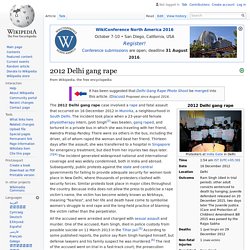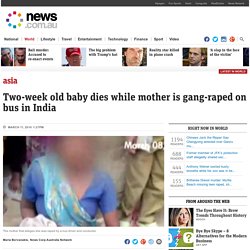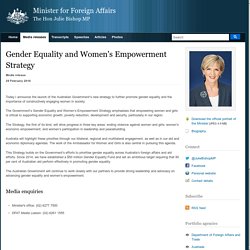

HSH112 SDG 5 Gender Inequality, Country = India, Thursday 9am.
Wid 9801. A Life Course Model of Human Rights Realization, Female Empowerment, and Gender Inequality in India.
Gender Equity Issues in India. Gender discrimination continues to be an enormous problem within Indian society.

Traditional patriarchal norms have relegated women to secondary status within the household and workplace. This drastically affects women's health, financial status, education, and political involvement. Women are commonly married young, quickly become mothers, and are then burdened by stringent domestic and financial responsibilities. They are frequently malnourished since women typically are the last member of a household to eat and the last to receive medical attention. Additionally, only 54 percent of Indian women are literate as compared to 76 percent of men.
Untitled. OD57. UNDP in India. Persistent Inequality.

Gender Equality and Empowerment » United Nations in India. A signatory to the Convention for the Elimination of Discrimination against Women (CEDAW) and the UN Convention on the Rights of the Child (CRC) India has a number of progressive laws that support gender equality and ending discrimination and violence against women.

The Government of India was represented at the 2013 session of the Commission on the Status of Women (CSW), where Member States committed to ending all forms of violence against women. They recognized that there is a need to address the economic and political underpinnings of violence; ensure access to justice; strengthen multi-sectoral approaches; and end harmful traditional practices that negatively impact women. Under the Sexual Harassment of Women at the Workplace (Prevention, Prohibition and Redressal) Act 2013, the Government of India has pledged to establish 100 One Stop Crisis Centres and the creation of a 1000 Crore Nirbhaya Fund to respond to Violence against Women and Girls. March 2015 - Theme of the Month.
Equal Half: Gender Responsive Budgeting and Planning in India. Pay gap between male and female cricketers. India Needs to “Save its Daughters” Through Education and Gender Equality. Active Citizens, Asia-Pacific, Education, Featured, Gender, Headlines, Health, Human Rights, Labour, Poverty & SDGs, TerraViva United Nations Women working the fields in India where a vast number farm, but make little money.

Credit: Neeta Lal/IPS. Empowering communities and strengthening systems to improve transgender health: outcomes from the Pehchan programme in India. The invisible ones: Sexual minorities. 2012 Delhi gang rape. The 2012 Delhi gang rape case involved a rape and fatal assault that occurred on 16 December 2012 in Munirka, a neighbourhood in South Delhi.

The incident took place when a 23-year-old female physiotherapy intern, Jyoti Singh[2] was beaten, gang raped, and tortured in a private bus in which she was traveling with her friend, Awindra Pratap Pandey. There were six others in the bus, including the driver, all of whom raped the woman and beat her friend. Thirteen days after the assault, she was transferred to a hospital in Singapore for emergency treatment, but died from her injuries two days later.[3][4] The incident generated widespread national and international coverage and was widely condemned, both in India and abroad. Subsequently, public protests against the state and central governments for failing to provide adequate security for women took place in New Delhi, where thousands of protesters clashed with security forces.
Incident[edit] Victims[edit] India’s Daughter rapist free: Juvenile out of jail in Jyoti Singh case. Loaded: 0% Progress: 0% India's Daughter is a documentary directed by Leslee Udwin and is part of the BBC's ongoing Storyville series.

The film is based on the 2012 Delhi gang rape and murder of Jyoti Singh, a 23-year-old woman. Indian women offer prayers for a gang rape victim in New Delhi, India. Picture: Dar Yasin/AP WARNING: Graphic content. Two-week old baby dies while mother is gang-raped on bus in India. The mother that alleges she was raped by a bus driver and conductor.

Maria BervanakisNews Corp Australia Network IT’S a shocking incident that beggars belief. A two-week old boy reportedly died after being thrown from his mother’s lap while she was being raped on a bus. The alleged offenders: the bus driver and conductor. The gruesome incident happened in the Sheeshgarh village in India on Monday night while the woman was returning home from a family function at a nearby village, The Times of India reports.
India is in denial about its rape culture - but then so are we. The Indian government is up in arms.

It has banned a documentary, India’s Daughter, which includes a reconstruction of the notorious gang rape and murder of a young woman on a bus in Delhi. Ministers can’t stop Leslee Udwin’s film being shown elsewhere – you might have seen it on BBC Four last week - but they would like it to be consigned to oblivion. It reflects badly on India, you see. The rape of the 23-year-old student took place just before Christmas 2012, bringing thousands of people on to the streets to demand greater protection for women.
All of this happened before the current prime minister, Narendra Modi, took office, but he would like the entire subject to just go away. India's Daughter Documentary - BBC Full. India's Daughter. Save the Souls Facebook Page. SaveTheSoul. True gender equality is when both women and men have a voice. Man commits suicide, wife files dowry harassment case against him : Mail Today, News. 1Woman files dowry harassment case against dead husband, his family2Woman complains to police she was subjected to unnatural sex3Woman denied bail in abetment to suicide case against her Anand Pilania's 30-year-old son committed suicide, alleging harassment by his wife and her relatives, but this is not the end of the ordeal for the 54-year-old man.

Faced with dowry allegations within two months of his son's death, adding to Pilania's woes is his daughter-in-law's complaint to the police that his son subjected her to unnatural sex. Legal hurdles. Gender Equality and Women's Empowerment Strategy, Media release, 29 Feb 2016, Australian Minister for Foreign Affairs, The Hon Julie Bishop MP. Today I announce the launch of the Australian Government’s new strategy to further promote gender equality and the importance of constructively engaging women in society.

The Government’s Gender Equality and Women’s Empowerment Strategy emphasises that empowering women and girls is critical to supporting economic growth, poverty reduction, development and security, particularly in our region. The Strategy, the first of its kind, will drive progress in three key areas: ending violence against women and girls; women’s economic empowerment; and women’s participation in leadership and peacebuilding. Australia will highlight these priorities through our bilateral, regional and multilateral engagement, as well as in our aid and economic diplomacy agendas. The work of the Ambassador for Women and Girls is also central in pursuing this agenda.
This Strategy builds on the Government’s efforts to prioritise gender equality across Australia’s foreign affairs and aid efforts. Gender equality and womens empowerment strategy. Gender inequality in India. The Gender gap index for India compared to other countries. Gender gap index is one of many multi-dimensional measures of gender inequality. India was scored at 0.66 by World Economic Forum, and ranked 101 out of 136 countries in 2013.[1] Gender inequality in India refers to health, education, economic and political inequalities between men and women in India.[1] Various international gender inequality indices rank India differently on each of these factors, as well as on a composite basis, and these indices are controversial.[2][3] Gender inequalities, and its social causes, impact India's sex ratio, women's health over their lifetimes, their educational attainment, and economic conditions.
Gender inequality in India is a multifaceted issue that concerns men and women alike. Gender statistics[edit] The following table compares the population wide data for the two genders on various inequality statistical measures, according to The World Bank's Gender Statistics database for 2012.[4] Social Institutions and Gender Index (SIGI) Agarwal, B. (2002) ‘Are We Not Peasants Too? Land Rights and Women’s Claims in India’, SEEDS, Population Council, (accessed 10 February 2014) Agnes, Flavia (2013) ‘No Short Cuts on Rape. Make the Legal System Work’. Female tourists should not wear skirts in India, says tourism minister. India’s tourism minister has said foreign women should not wear skirts or walk alone at night in the country’s small towns and cities “for their own safety”.
Discussing tourist security in the north Indian city of Agra, site of the Taj Mahal, Mahesh Sharma said foreign arrivals to India were issued a welcome kit that included safety advice for women. “In that kit they are given dos and don’ts,” he said on Sunday. Indian police investigate gang-rape of American tourist. An American tourist has told police she was gang-raped in northern India earlier this week, officials in the town of Dharamsala have said. The 46-year-old Californian woman arrived in India about a month ago and had travelled alone to Dharamsala, the home of the Dalai Lama and a popular tourist destination 300 miles north of the capital, Delhi. She had described walking through the town’s main market when two men grabbed hold of her.
Women walk alone to reclaim India's streets from fear and harassment. After a long and tiring day, Neha Khandelwal, 26, fell asleep on the bus in Delhi on her way home. She woke up, startled, when she felt someone grab her breasts. Drowsy and not completely alert, it took her a minute to gauge what had happened. The man sitting next to her on the bus was groping her. “I felt so vulnerable … that anybody could subject my body to something that I did not want,” she says.
4 out of 5 Indian Women Have Been Sexually Harassed In Public. AdBlock Plus. Dear India's tourism minister, let women exercise their freedom. As I write this letter to you, I recall a recent trip I took to Shillong in the north east of India. India's tourism minister facing backlash after telling female tourists not to wear skirts. The Cry of India’s Daughters.
By Joseph D’Souza, for TheBlaze. Gender Data Portal. Women in the Workforce: India. Population. Global Gender Gap Report 2014. Indianexpress. How India’s Dutee Chand ran past gender barriers to compete in Rio. Despite sporting glory, Indian women struggle to rise. Saumya Tewari/IndiaSpend/IANS In the 2016 Rio Olympics, shuttler P.V. Sindhu became the first Indian woman to win a silver medal; Sakshi Malik the first Indian female wrestler to win a medal (bronze), gymnast Dipa Karmarkar became the first Indian woman to feature in a gymnastics final, finishing fourth in the vault, and Lalita Babar became the first Indian woman to enter a 3,000 metre steeplechase final, finishing 10th. Eighteen-year-old Aditi Ashok -- the youngest golfer from India -- also entered the final round of the women's individual golf event. Women saved the day for India at Rio, and their growing presence was reflected in the 54 female Indian athletes -- the largest number ever -- at an Olympiad. 1.
Why girls in India are still missing out on the education they need. Meena (not her real name) didn't tell her parents when the older boys started harassing her on the hour-long walk to school from her home in Madanpur Khadar, south Delhi – grabbing her hand and shouting "kiss me" – because she knew she would get the blame, as if she had somehow encouraged them. Indian women are more educated, but less employed. Right to Education Project. Five-Year Plans of India. History[edit] Five-Year Plans (FYPs) are centralized and integrated national economic programs. Joseph Stalin implemented the first FYP in the Soviet Union in the late 1920s. Most communist states and several capitalist countries subsequently have adopted them. China and India both continue to use FYPs, although China renamed its Eleventh FYP, from 2006 to 2010, a guideline (guihua), rather than a plan (jihua), to signify the central government’s more hands-off approach to development.
India launched its First FYP in 1951, immediately after independence under socialist influence of first Prime Minister Jawaharlal Nehru.[3] The First Five-Year Plan was one of the most important because it had a great role in the launching of Indian development after the Independence. First Plan (1951–1956)[edit] The first Indian Prime Minister, Jawaharlal Nehru presented the First Five-Year Plan to the Parliament of India and needed urgent attention. Second Plan (1956–1961)[edit] Budget Objectives. Rape culture and sexism in India.